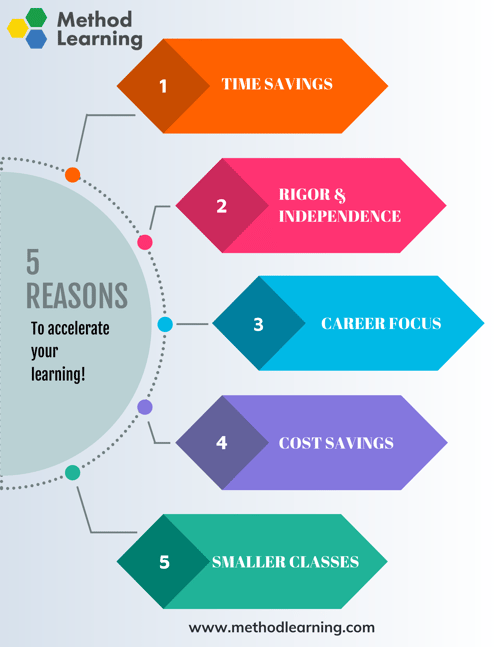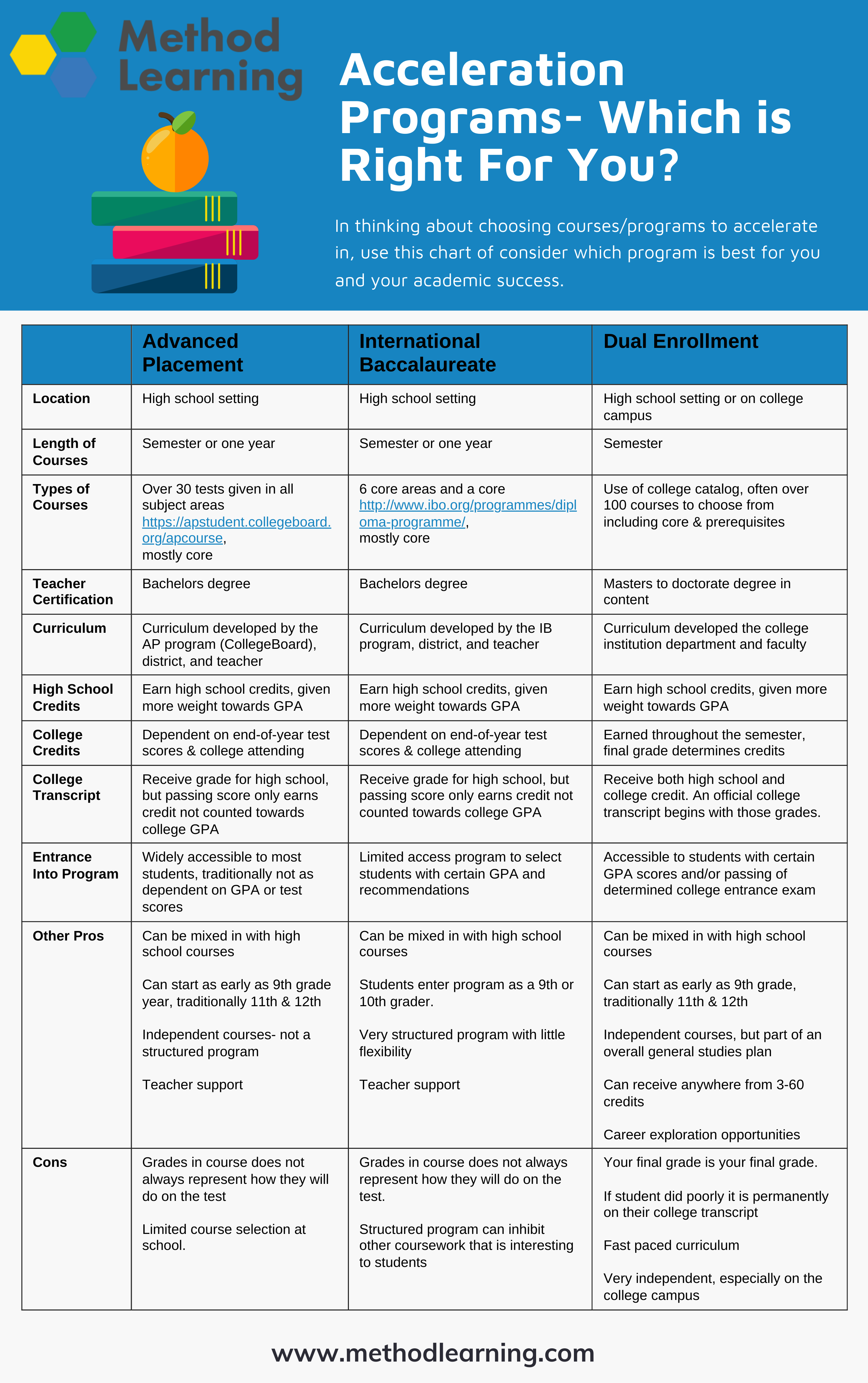Your Guide to High School Acceleration
High school students have great opportunities to obtain free college credits even before graduating high school! Today, high schools provide many opportunities for students to accelerate their learning through various high school programming. Earning college credit in high school is beneficial for multiple reasons.

Time Savings
While not widely discussed, college is taking longer to get through as students change their degrees, have trouble meeting prerequisites, or enter programs that change their requirements. Having a student be able to focus on the generalized core courses or electives to determine their major, these credits can save students a substantial amount of time and stress.
Rigor & Independence
Acceleration courses allow students to be treated as college-students. Students learn to better navigate the academic skills, such as time management, study skills, test preparation, and note taking, to be a more successful student. Having both rigor and independence can be highly motivating for students to excel and shows colleges that students can handle college-level coursework.
Career Focus
The college course work allows students to see how they might enjoy specific career fields. Advanced lab reports, research, hands-on projects, and in-depth teaching provides more opportunities for exploration into various career fields. Students can also earn industry certifications that can be directly employable after high school or with additional semester or two.
Cost Savings
School districts often pick up the tab for tuition and books. Sometimes there are some small fees, but at a fraction of the cost what a student would pay after graduating high school, including room and board, tuition, fees, books, and other expenses.
Smaller Classes
Taking these courses in high school or on a state college's campus guarantees small numbers and more personalized attention.
Three Main Acceleration Methods
Advanced Placement-
Advanced Placement- implemented by the College Board, are standard curriculum
courses taught by high school teachers. Students are given an end-of-the-year test,
that provides them a score from 1-5. Based on this score, colleges and universities
determine if college credit can be earned. Over 2.7 million students worldwide are
expected to take up to 5 million exams this year.
- Strengths- AP is one the largest and oldest acceleration methods. It gives opportunities for all types of students to take singleton courses for potential college credits. College credits are often given for certain scores, but not all universities accept AP credits. Students can take courses they are stronger in rather than a whole program.
- Weaknesses- While the student may do well in the classroom environment, some students struggle on the extensive standardized test. As well, colleges have differing scores needed to obtain college credit. For more information about AP options- visit CollegeBoard.org.
Cambridge AICE and International Baccalaureate
Cambridge AICE and International Baccalaureate- The AICE and IB programs aresimilar in curriculum structure with an emphasis on intellectual rigor, high
academic standards, and strong emphasis on citizenship. Students often apply in
8th grade with standardized test scores, application, and possible interview.
- Strengths- Courses taught in the high school setting, but becomes a “school-within-a-school” setting as only a select number of students may enter the program. Students may earn up to 45 credits through passage of the final, standardized test. The programs are internationally recognized.
- Weaknesses- AICE and IB are extremely rigorous, structured, writing intensive programs. Some students do not thrive academically in this type of environment, some do.
Dual Enrollment
Dual enrollment courses are college courses that can be utilized in three ways; on a high school campus with a credentialed professor, online through the college, or at the college campus. Unlike the other programs, dual enrollment students have to meet the high school, college and maybe state requirements of a certain grade point average, specific test scores on standardized tests like the PERT, ACT, or SAT, or prerequisite courses.
- Strengths- Students earn college credits with passing grades to transfer to a four-year university or college. College courses are also by semester, so students can earn credits at a faster rate than other acceleration methods that are yearlong, such as AP, AICE, and IB. DE students have full access to the college’s resources, such as the library, academic resource centers, tutoring, activities, and Honor’s Program.
- Weaknesses-Students are treated as a college student and are expected to have academic independence. Student’s are creating their college official transcript.
No matter what grade you are in, it is always important to assess where you are academically. Asking yourself these questions will help you navigate which classes are best for you:
-
What are my academic interests and career goals?
- Understanding your interests and career aspirations can guide your choice of college prep courses. Certain courses may align more closely with your intended major or future profession.
-
What are the college admissions requirements for my preferred colleges?
- Researching the admission requirements of your target colleges is crucial. Some colleges may prefer or even require specific advanced courses, and tailoring your selections accordingly can enhance your application.
-
How challenging do I want my high school curriculum to be?
- Consider your comfort level with academic challenges. While pushing yourself is beneficial, it's essential to strike a balance to ensure you can manage the workload effectively.
-
Do I have a preference for a particular type of college prep program (AP, IB, AICE, DE)?
- Different college prep programs offer distinct approaches to advanced coursework. Research each program's structure, assessment methods, and philosophies to determine which aligns best with your learning style and preferences.
-
How do these courses align with my long-term educational goals?
- Evaluate how each course contributes to your overall educational goals. Some courses may provide college credits, potentially saving time and money in the long run, while others may offer a more comprehensive and interdisciplinary approach.
-
What support resources are available for these courses at my school?
- Consider the support system in place for each course. Access to experienced teachers, study groups, and additional resources can significantly impact your success in these challenging courses.
Remember, the goal is not just to take the most challenging courses but to create a well-rounded and manageable curriculum that aligns with your aspirations. These questions should help you make informed decisions about your college prep course selections.


Dr. Amanda Sterk
Dr. Amanda Sterk is the Director of College and Career Advising at Method Learning. Dr. Sterk has guided thousands of students through academic planning, career exploration, and applying and succeeding in college admissions and scholarships. She is co-author of the nationally recognized college admissions workbook, College UnMazed: Your Guide to Navigate the High School to College Maze. Dr. Sterk graduated with her Bachelors in Education from the University of Northern Iowa, Masters in Counseling from Drake University, and Doctorate in Educational Leadership from Creighton University.


